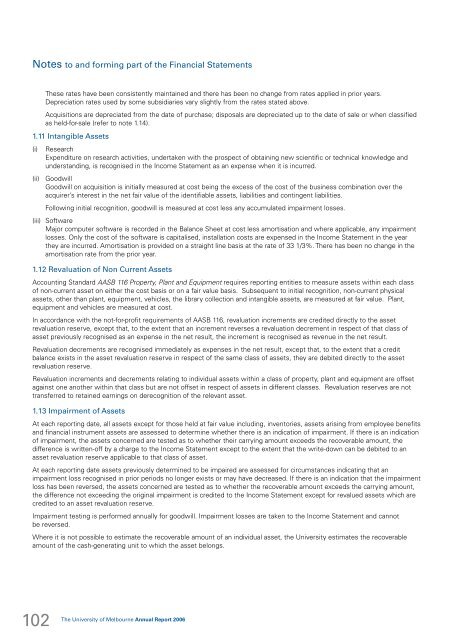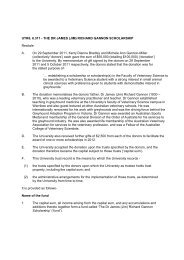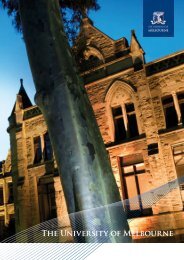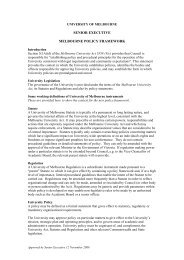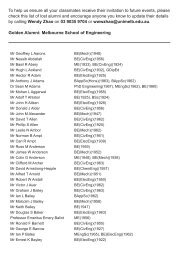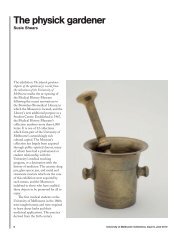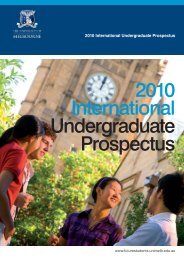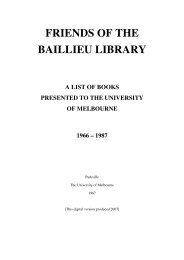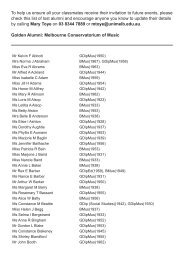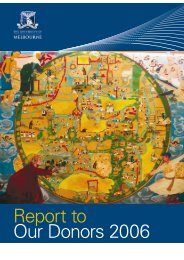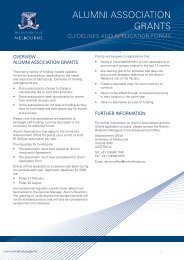annual report/2006 - University of Melbourne
annual report/2006 - University of Melbourne
annual report/2006 - University of Melbourne
Create successful ePaper yourself
Turn your PDF publications into a flip-book with our unique Google optimized e-Paper software.
Notes to and forming part <strong>of</strong> the Financial Statements<br />
These rates have been consistently maintained and there has been no change from rates applied in prior years.<br />
Depreciation rates used by some subsidiaries vary slightly from the rates stated above.<br />
Acquisitions are depreciated from the date <strong>of</strong> purchase; disposals are depreciated up to the date <strong>of</strong> sale or when classified<br />
as held-for-sale (refer to note 1.14).<br />
1.11 Intangible Assets<br />
(i)<br />
Research<br />
Expenditure on research activities, undertaken with the prospect <strong>of</strong> obtaining new scientific or technical knowledge and<br />
understanding, is recognised in the Income Statement as an expense when it is incurred.<br />
(ii) Goodwill<br />
Goodwill on acquisition is initially measured at cost being the excess <strong>of</strong> the cost <strong>of</strong> the business combination over the<br />
acquirer’s interest in the net fair value <strong>of</strong> the identifiable assets, liabilities and contingent liabilities.<br />
Following initial recognition, goodwill is measured at cost less any accumulated impairment losses.<br />
(iii) S<strong>of</strong>tware<br />
Major computer s<strong>of</strong>tware is recorded in the Balance Sheet at cost less amortisation and where applicable, any impairment<br />
losses. Only the cost <strong>of</strong> the s<strong>of</strong>tware is capitalised, installation costs are expensed in the Income Statement in the year<br />
they are incurred. Amortisation is provided on a straight line basis at the rate <strong>of</strong> 33 1/3%. There has been no change in the<br />
amortisation rate from the prior year.<br />
1.12 Revaluation <strong>of</strong> Non Current Assets<br />
Accounting Standard AASB 116 Property, Plant and Equipment requires <strong>report</strong>ing entities to measure assets within each class<br />
<strong>of</strong> non-current asset on either the cost basis or on a fair value basis. Subsequent to initial recognition, non-current physical<br />
assets, other than plant, equipment, vehicles, the library collection and intangible assets, are measured at fair value. Plant,<br />
equipment and vehicles are measured at cost.<br />
In accordance with the not-for-pr<strong>of</strong>it requirements <strong>of</strong> AASB 116, revaluation increments are credited directly to the asset<br />
revaluation reserve, except that, to the extent that an increment reverses a revaluation decrement in respect <strong>of</strong> that class <strong>of</strong><br />
asset previously recognised as an expense in the net result, the increment is recognised as revenue in the net result.<br />
Revaluation decrements are recognised immediately as expenses in the net result, except that, to the extent that a credit<br />
balance exists in the asset revaluation reserve in respect <strong>of</strong> the same class <strong>of</strong> assets, they are debited directly to the asset<br />
revaluation reserve.<br />
Revaluation increments and decrements relating to individual assets within a class <strong>of</strong> property, plant and equipment are <strong>of</strong>fset<br />
against one another within that class but are not <strong>of</strong>fset in respect <strong>of</strong> assets in different classes. Revaluation reserves are not<br />
transferred to retained earnings on derecognition <strong>of</strong> the relevant asset.<br />
1.13 Impairment <strong>of</strong> Assets<br />
At each <strong>report</strong>ing date, all assets except for those held at fair value including, inventories, assets arising from employee benefits<br />
and financial instrument assets are assessed to determine whether there is an indication <strong>of</strong> impairment. If there is an indication<br />
<strong>of</strong> impairment, the assets concerned are tested as to whether their carrying amount exceeds the recoverable amount, the<br />
difference is written-<strong>of</strong>f by a charge to the Income Statement except to the extent that the write-down can be debited to an<br />
asset revaluation reserve applicable to that class <strong>of</strong> asset.<br />
At each <strong>report</strong>ing date assets previously determined to be impaired are assessed for circumstances indicating that an<br />
impairment loss recognised in prior periods no longer exists or may have decreased. If there is an indication that the impairment<br />
loss has been reversed, the assets concerned are tested as to whether the recoverable amount exceeds the carrying amount,<br />
the difference not exceeding the original impairment is credited to the Income Statement except for revalued assets which are<br />
credited to an asset revaluation reserve.<br />
Impairment testing is performed <strong>annual</strong>ly for goodwill. Impairment losses are taken to the Income Statement and cannot<br />
be reversed.<br />
Where it is not possible to estimate the recoverable amount <strong>of</strong> an individual asset, the <strong>University</strong> estimates the recoverable<br />
amount <strong>of</strong> the cash-generating unit to which the asset belongs.<br />
102<br />
The <strong>University</strong> <strong>of</strong> <strong>Melbourne</strong> Annual Report <strong>2006</strong>


